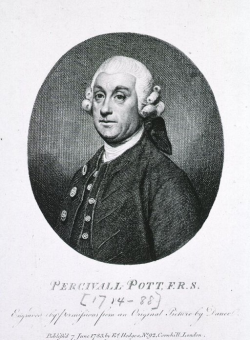Sir Percival Pott

Sir Percival Pott
- Born
- 6 January 1714
- Died
- 22 December 1788 (age 74)
Sir Percival Pott was a surgeon, a founder of orthopaedics and the first scientist to demonstrate that an environmental carcinogen could cause cancer.
Pott was born into a large family in the city of London, and became an apprentice at St Bartholomew’s hospital, where he was appointed as a resident surgeon in 1736. As a student, he had to dissect bodies for anatomy demonstrations, which no doubt helped him develop his surgical skills.
As a surgeon, Pott introduced some new approaches which helped to make the surgery of the time more humane. These helped to abolish the use of escharotics (using a substance such as an acid or alkali that causes tissue to slough off) and cautery (burning part of a body to close it off which was mistakenly believed to lower the risk of infection). In 1765, Pott was elected Master of the Company of Surgeons, which later became the Royal College of Surgeons.
In 1756, on his way to see a patient, Pott fell from his horse and suffered a broken leg. The general consensus of medical opinion was that his leg should be amputated. However, his teacher, Edward Nourse, advised that his leg should be placed in a splint instead. Pott eventually made a full recovery. It was during his period of convalescence that he began to produce the medical texts that brought him international recognition, including A treatise on Ruptures which established his reputation.
He gave his name to a number of conditions, including Potts fracture and Potts puffy tumour. He was the first to describe arthritic tuberculosis of the spine, which became know as Pott’s disease of the spine.
among the pioneers of occupational medicine
John R Brown and John L Thornton, writing in British Journal of Industrial Medicine, January 1957, 14 (1), pp68-70.
In 1775, Pott discovered the first occupational link to cancer, when he found an association between exposure to soot and incidences of scrotal cancer in chimney sweeps. Many chimney sweeps suffered from sores on their scrotums and these were widely believed to be venereal disease.
However, Pott realised something else was happening. His early investigations contributed to epidemiology and the Chimney Sweepers Act 1788, which made it illegal to employ children under the age of eight. Pott's work laid the foundations for occupational medicine and measures to prevent diseases caused by work.
Pott’s studies helped to initiate the first epidemiological study which took place in the 1930s. This involved painting coal tar onto the skin of mice, which proved the role of the first chemical carcinogen, benzo(a)pyrene. This is a carcinogen that occurs in high concentrations in smoke and chimney soot. This was the first time it had been demonstrated that cancer could be caused by an external factor as well as an internal one and it led to important insights into the link between cancer and carcinogens.



